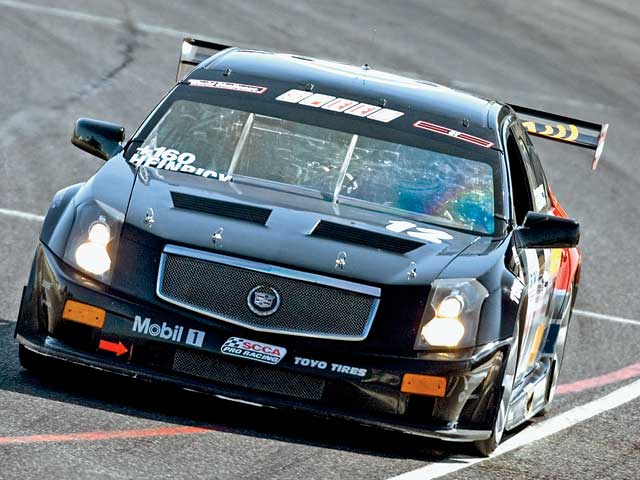
John Heinricy has been tagged “Heinrocket” for good reason. He’s one fast race car driver and has a boatload of trophies to prove it.
He is best known as a Bowtie guy, having driven many GM machines to victory lane over nearly 35 years of racing. The “Heinrocket” has stood on the top step at the SCCA National Championship Runoffs 15 times, second only to long-retired Jerry Hansen’s 27. Hansen is well into his 80s and unlikely to mount a comeback.
Heinricy has taken the green flag in more than 240 professional races, including 35 24-hour events resulting in four professional drivers’ championships and three FIA world speed records.
An engineer by profession, Heinricy has played major roles in the design and development of GM’s racing programs. He has served as assistant chief engineer for the Corvette and as director of the GM Performance Division. Look for Heinricy’s fingerprints as one of the reasons why those screaming yellow race cars have such a fearsome on-track reputation.
Heinricy retired from GM in October 2008 and formed a high-performance automotive consultancy, dubbed, wait for it, “Heinrocket.”
Heinricy began racing in 1984. As mentioned earlier, he has a long and storied relationship with GM, only straying off “the reservation” a couple of times with Subaru, briefly with Ford and most recently Toyota.
Looking back over Heinricy’s career is a literal tour de force.
He has consulted on numerous racing projects for GM teams, including the development of the Cadillac CTS-V, and had a hand in producing various GM hot rods such as the supercharged Saturn Redline ION, the supercharged Chevrolet Cobalt SS, the supercharged Cadillac XLR-V and STS-V, the Chevrolet Trailblazer SS, the turbocharged Chevrolet Cobalt SS, the turbocharged HHR SS, the supercharged Buick Super, the Chevrolet Camaro SS and the Pontiac G8 GXP.

Not forsaking the lesser models in the GM lineup, Heinricy has actively campaigned a Chevy Sonic, winning an SCCA championship in one at the 2015 Runoffs.
Developing a winning car is a blend of art and science. For Heinricy, it’s the difference between winning and losing.
“A lot of development is necessary if you want to do it well. If you have a car that’s an overdog you just take it and run and win,” Heinricy said. “I’d say that’s kind of unusual. Most of the time the cars are pretty damn competitive with one another. So if you want to win you have to go through it, tweak it, make it work for you.
“It’s not just about making the car fast, it’s making the car feel comfortable to you and get everything out of it,” he added. “It may not be as good as another car but if you can make it right for the driver you can make up for it if they (a competitor) hasn’t made their car good enough for them.”
Heinricy has a thing or two to say about making cars fast. In a 2009 Corvette Magazine story, he shared what he learned at GM and his involvement with Pratt & Miller, the outfit that has built and campaigned the Corvette Racing cars.
“It was a step up for me to see the way that team was run and the engineering that was going into the car,” he said. “That was the biggest difference in racing with that team compared to what I had driven before.
“I got to see the level of professionalism that goes into racing those cars and how they were engineered at a high level,” Heinricy added. “They turned out to be terrific cars. The other thing that opened my eyes about that experience was the sharing of not just hardware.
“For example, when you think about when we were racing in the 1980s in the Escort endurance series, we were doing things that made the cars better and faster,” he noted. “It was production car engineering, not racing engineering. In 1984 wheel bearings broke, so we re-engineered them to fix the problem. We found a significant number of things in racing that we did rapid engineering fixes to change in the production car.”
The 2009 story rolls over to other GM marques.
“I pushed Herb Fishel to get a racing program going for the (Cadillac) CTS-V and felt that World Challenge was the right place for the car,” Heinricy said. “We started talking about this while engineering the CTS-V for the street. I had engineers assigned to work with Pratt & Miller at GM Racing on developing the World Challenge Cadillac. That just continued building up expertise within our group.
“At the same time, I had another group working on the supercharged Cobalt for the Grand-Am Cup (IMSA Michelin Challenge Series), so there was a lot of interchange going on between racing and production. Out of that we ended up establishing a race vehicle-engineering group in our organization.”
Heinricy has an enviable legacy. He’s got all the trophies and team shirts anybody would ever want. One would think enough is enough, but it’s not.
Now 72 years old, an age where most racers only talk about how fast they were “back then,” Heinricy still has his foot to the floor.
“It’s too much fun. I just enjoy it so much,” he said. “Technically, I like it. Competitively, I like it. As long as I can do it and do it well enough, I have no desire to stop doing it. My wife is completely on board with that.”
When mama is happy, everybody is happy.
The clock may run out before the “Heinrocket” catches Hansen, but there’s no doubt he will give that quest his very best. He’s shooting for two more Runoffs titles in A Sedan and T4 this year.
